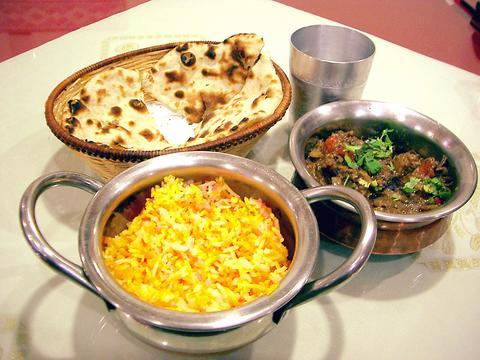A few of Taipei's locally run restaurants can produce a reasonable curry without using ingredients from India, however, the better curries will always be those prepared by a native chef.
Out of India is the latest Indian fare to hit the Taipei market. With less than two months on the scene, people are already queuing up for its homemade curries and tandoori meats. Compared with the other six authentic Indian restaurants in the city, however, there is some question as to how long Out of India will still be in Taipei.

PHOTO: DIANA FREUNDL, TAIPEI TIMES
He has studied Chinese at Shida for the past five years, but the restaurant's owner and chef, Andy, worked in a kitchen in northern India before bringing his Punjabi cuisine to Taiwan. The New Delhi native said he wanted to target the student market by offering reasonably priced Indian meals. His prices are slightly cheaper than those at other eateries and include a lunch time set meal with veggie curry, rice, salad and a drink for NT$150. A large set meal with soup, chicken tikka, curry, rice, butter nan and masala milk tea is also available at lunch and dinner for NT$350.
The most popular items, he said, are those from the clay oven. There is a mixed grill combination of tandoori chicken, mutton, fish and prawns (NT$450). In addition to the usual selection of chicken, mutton and fish curries, masalas and vindaloos are a few specialty dishes such as mutton kadaise (cooked with onion, tomatoes and herbs in a kadai Indian wok) and a Goa style fish curry.
When asked, the waitress said all ingredients were from India, except a local brand of butter used to make the daal. It had such a poignant taste that after eating only a few spoon fulls it was difficult to tell whether or not the others dishes had also used it.
The nan was good, as was the basmati rice, which is used to make the biryani and pulao. Dessert is inexpensive at NT$50 and includes a choice between gulab jamun and Indian sweet yogurt.
There is seating for 24 on the main floor and a basement party room that holds 20 and can be rented out for private functions. Given how fast the restaurant filled up last Sunday (30 minutes after opening and every one arriving around the same time) the service was fast and friendly.
Out of India might not have the best tasting vegetarian curries in Taipei but it definitely has the best decor. The red painted trim and tasteful collection of tapestries on the wall give it a warm ethnic look, but don't quite make up for the substandard daal.

On April 26, The Lancet published a letter from two doctors at Taichung-based China Medical University Hospital (CMUH) warning that “Taiwan’s Health Care System is on the Brink of Collapse.” The authors said that “Years of policy inaction and mismanagement of resources have led to the National Health Insurance system operating under unsustainable conditions.” The pushback was immediate. Errors in the paper were quickly identified and publicized, to discredit the authors (the hospital apologized). CNA reported that CMUH said the letter described Taiwan in 2021 as having 62 nurses per 10,000 people, when the correct number was 78 nurses per 10,000

As we live longer, our risk of cognitive impairment is increasing. How can we delay the onset of symptoms? Do we have to give up every indulgence or can small changes make a difference? We asked neurologists for tips on how to keep our brains healthy for life. TAKE CARE OF YOUR HEALTH “All of the sensible things that apply to bodily health apply to brain health,” says Suzanne O’Sullivan, a consultant in neurology at the National Hospital for Neurology and Neurosurgery in London, and the author of The Age of Diagnosis. “When you’re 20, you can get away with absolute

May 5 to May 11 What started out as friction between Taiwanese students at Taichung First High School and a Japanese head cook escalated dramatically over the first two weeks of May 1927. It began on April 30 when the cook’s wife knew that lotus starch used in that night’s dinner had rat feces in it, but failed to inform staff until the meal was already prepared. The students believed that her silence was intentional, and filed a complaint. The school’s Japanese administrators sided with the cook’s family, dismissing the students as troublemakers and clamping down on their freedoms — with

As Donald Trump’s executive order in March led to the shuttering of Voice of America (VOA) — the global broadcaster whose roots date back to the fight against Nazi propaganda — he quickly attracted support from figures not used to aligning themselves with any US administration. Trump had ordered the US Agency for Global Media, the federal agency that funds VOA and other groups promoting independent journalism overseas, to be “eliminated to the maximum extent consistent with applicable law.” The decision suddenly halted programming in 49 languages to more than 425 million people. In Moscow, Margarita Simonyan, the hardline editor-in-chief of the